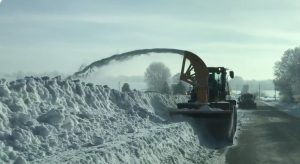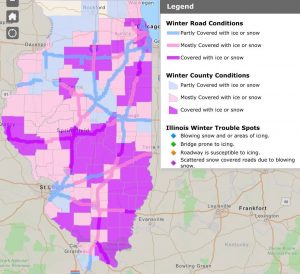Keeping safe as extreme cold and snow sweep across Illinois
Chronicle Media — February 15, 2021
 The Illinois Department of Transportation and Illinois State Police are warning the public that a major winter storm will create hazardous conditions across the state, urging drivers to strongly consider postponing any unnecessary travel.
The Illinois Department of Transportation and Illinois State Police are warning the public that a major winter storm will create hazardous conditions across the state, urging drivers to strongly consider postponing any unnecessary travel.
Throughout Illinois, intense periods of heavy snow and continued bitter cold should be anticipated, creating extremely slick conditions and poor visibility.
“As always, our team at IDOT will be out on the roads around the clock, but if you can stay indoors, please do, especially during the overnight hours,” said Acting Illinois Transportation Secretary Omer Osman. “Conditions at times could be treacherous, with the cold and wind reducing the effectiveness of the materials we use to treat snow and ice. Expect extremely long travel times and always prepare your vehicle in the event you are stranded.”
The National Weather Service has issued a storm warning for Monday and Tuesday, Feb. 15 and 16, predicting the heaviest snow to fall late Monday afternoon and evening. Between 6 to 12 inches are expected east of Interstate 57, with some of the heaviest amounts in Chicago, the Metro East and far southern Illinois.
Along the entire Interstate 55 corridor, 5 to 8 inches are possible. In northwest Illinois, 1 to 2 inches are anticipated. Blowing and drifting snow throughout the state are likely due to the amounts and fluffiness of the snow combined with high winds.
Statewide, IDOT has available more than 1,800 trucks and equipment to treat roads and respond to weather emergencies. If you encounter a plow or any maintenance vehicle during your travels, please slow down, increase your driving distance and remain patient.
“If you must travel, we ask that you allow additional time to reach your destination and ensure your vehicle is in a safe operating condition,” said ISP Director Brandon Kelly. “Please obey all traffic laws and posted speed limits. Remember, speed limits are set for clear conditions. Only drive the speed limit if it is safe to do so. And please watch out for emergency responders and highway maintainers who are doing their best to keep the roadways safe.”
Other tips if you must travel:
• Take it slow, especially when approaching intersections, ramps, bridges and shaded areas that are prone to icing.
• Make sure your gas tank is full.
• Keep a cell phone, warm clothes, blankets, food, water, a first-aid kit, washer fluid and an ice scraper in your vehicle.
• Check the forecast and make sure someone is aware of your route and schedule.
• Carry a cellphone and dial *999 in the Chicago area for assistance in case of emergency.
• Reminder: Using handheld phones while driving is illegal in Illinois, unless it is an emergency situation.
• If you are involved in a crash or break down, remain inside your vehicle, which is your safest form of shelter. Exiting your vehicle into live traffic can have fatal consequences.
• Always wear a seat belt, whether you’re sitting in the front seat or back seat. It’s the law.
For regular updates on statewide road conditions, visit www.gettingaroundillinois.com. You also can follow IDOT on Facebook and Twitter.
Stay Safe
The American Red Cross has safety tips to help you prepare and deal with this winter weather.
- Be aware of the wind chill. Avoid staying in the cold too long.
- Wear layers of clothing to stay warm, along with a hat, mittens and waterproof, insulated boots to keep feet warm and dry. Avoid unnecessary exposure of any part of the body to the cold.
- Be careful when tackling strenuous tasks like shoveling snow in cold temperatures. Take frequent breaks from the cold.
- Drink plenty of warm fluids or warm water but avoid caffeine and alcohol.
- Get out of the cold immediately if the signs of hypothermia and frostbite appear.
- Check on your neighbors, especially elderly people living alone, people with disabilities and children.

The Illinois Department of Transportation reminds motorists that if you see snow plows and snowblowers pushing back snow, reduce your speed and give them space. (Courtesy of IDOT)
At home:
-
- Bring family pets indoors. If that’s not possible, provide adequate shelter to keep them warm and make sure they can get to unfrozen water.
- Prevent frozen pipes. Open cabinet doors to let warm air circulate around water pipes. Let the cold water drip from the faucet served by exposed pipes.
- Do not use a stove or oven to heat the home. Keep a glass or metal fire screen around the fireplace and never leave a fireplace fire unattended.
- If using a space heater, place it on a level, hard, nonflammable surface. Don’t place it on rugs and carpets, or near bedding and drapes. Keep children and pets away from the space heater and do not use it to dry wet clothing. Plug space heater power cords directly into outlets – never into an extension cord. Turn the space heater off when leaving the room or going to sleep.
- If the power goes out, use generators correctly. Never operate a generator inside the home, including the basement or garage. Do not hook up a generator directly to the home’s wiring. The safest thing to do is to connect the equipment needed directly to the outlets on the generator.
On the road:
-
-
- Stay off the road during sever weather, if possible.
- Carry an emergency preparedness kit in the trunk.
- Keep the car’s gas tank full for emergency use and to keep the fuel line from freezing.
- Make sure everyone has their seat belts on and give your full attention to the road.
- Don’t follow other vehicles too closely. Sudden stops are difficult on snowy roadways.
- Don’t use cruise control when driving in winter weather.
- Don’t pass snowplows.
- Know that ramps, bridges and overpasses freeze before roadways.
-
Find more winter weather safety information here.




